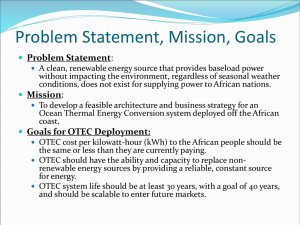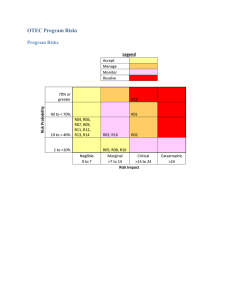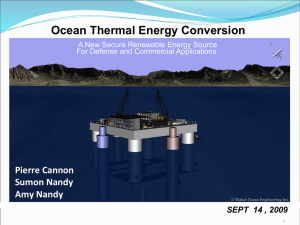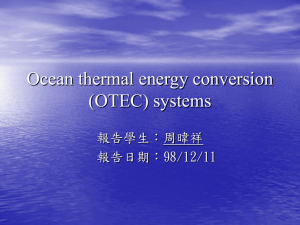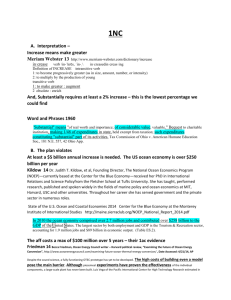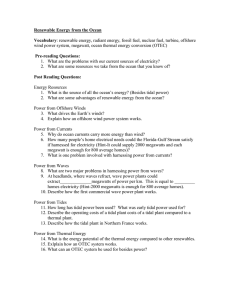OCEAN THERMAL ENERGY CONVERSION (OTEC)
advertisement
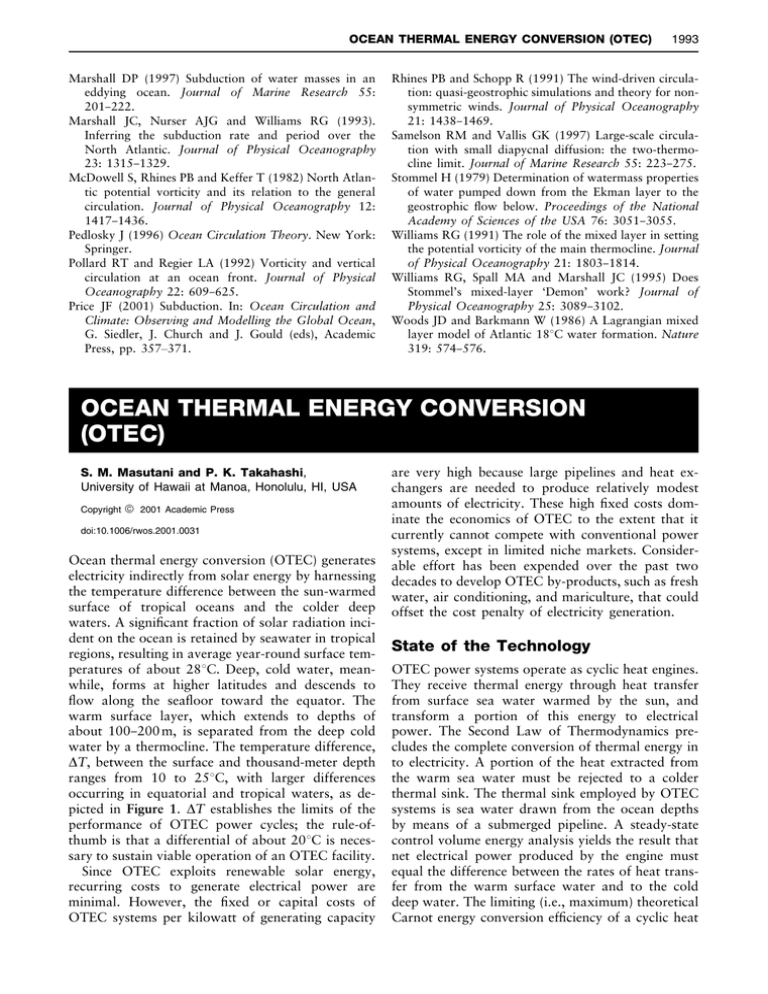
OCEAN THERMAL ENERGY CONVERSION (OTEC) Marshall DP (1997) Subduction of water masses in an eddying ocean. Journal of Marine Research 55: 201}222. Marshall JC, Nurser AJG and Williams RG (1993). Inferring the subduction rate and period over the North Atlantic. Journal of Physical Oceanography 23: 1315}1329. McDowell S, Rhines PB and Keffer T (1982) North Atlantic potential vorticity and its relation to the general circulation. Journal of Physical Oceanography 12: 1417}1436. Pedlosky J (1996) Ocean Circulation Theory. New York: Springer. Pollard RT and Regier LA (1992) Vorticity and vertical circulation at an ocean front. Journal of Physical Oceanography 22: 609}625. Price JF (2001) Subduction. In: Ocean Circulation and Climate: Observing and Modelling the Global Ocean, G. Siedler, J. Church and J. Gould (eds), Academic Press, pp. 357d371. 1993 Rhines PB and Schopp R (1991) The wind-driven circulation: quasi-geostrophic simulations and theory for nonsymmetric winds. Journal of Physical Oceanography 21: 1438}1469. Samelson RM and Vallis GK (1997) Large-scale circulation with small diapycnal diffusion: the two-thermocline limit. Journal of Marine Research 55: 223}275. Stommel H (1979) Determination of watermass properties of water pumped down from the Ekman layer to the geostrophic Sow below. Proceedings of the National Academy of Sciences of the USA 76: 3051}3055. Williams RG (1991) The role of the mixed layer in setting the potential vorticity of the main thermocline. Journal of Physical Oceanography 21: 1803}1814. Williams RG, Spall MA and Marshall JC (1995) Does Stommel’s mixed-layer ‘Demon’ work? Journal of Physical Oceanography 25: 3089}3102. Woods JD and Barkmann W (1986) A Lagrangian mixed layer model of Atlantic 183C water formation. Nature 319: 574}576. OCEAN THERMAL ENERGY CONVERSION (OTEC) S. M. Masutani and P. K. Takahashi, University of Hawaii at Manoa, Honolulu, HI, USA Copyright ^ 2001 Academic Press doi:10.1006/rwos.2001.0031 Ocean thermal energy conversion (OTEC) generates electricity indirectly from solar energy by harnessing the temperature difference between the sun-warmed surface of tropical oceans and the colder deep waters. A signiRcant fraction of solar radiation incident on the ocean is retained by seawater in tropical regions, resulting in average year-round surface temperatures of about 283C. Deep, cold water, meanwhile, forms at higher latitudes and descends to Sow along the seaSoor toward the equator. The warm surface layer, which extends to depths of about 100}200 m, is separated from the deep cold water by a thermocline. The temperature difference, T, between the surface and thousand-meter depth ranges from 10 to 253C, with larger differences occurring in equatorial and tropical waters, as depicted in Figure 1. T establishes the limits of the performance of OTEC power cycles; the rule-ofthumb is that a differential of about 203C is necessary to sustain viable operation of an OTEC facility. Since OTEC exploits renewable solar energy, recurring costs to generate electrical power are minimal. However, the Rxed or capital costs of OTEC systems per kilowatt of generating capacity are very high because large pipelines and heat exchangers are needed to produce relatively modest amounts of electricity. These high Rxed costs dominate the economics of OTEC to the extent that it currently cannot compete with conventional power systems, except in limited niche markets. Considerable effort has been expended over the past two decades to develop OTEC by-products, such as fresh water, air conditioning, and mariculture, that could offset the cost penalty of electricity generation. State of the Technology OTEC power systems operate as cyclic heat engines. They receive thermal energy through heat transfer from surface sea water warmed by the sun, and transform a portion of this energy to electrical power. The Second Law of Thermodynamics precludes the complete conversion of thermal energy in to electricity. A portion of the heat extracted from the warm sea water must be rejected to a colder thermal sink. The thermal sink employed by OTEC systems is sea water drawn from the ocean depths by means of a submerged pipeline. A steady-state control volume energy analysis yields the result that net electrical power produced by the engine must equal the difference between the rates of heat transfer from the warm surface water and to the cold deep water. The limiting (i.e., maximum) theoretical Carnot energy conversion efRciency of a cyclic heat 1994 OCEAN THERMAL ENERGY CONVERSION (OTEC) Longitude 40°E 80°E 120°E 160°E 160°W 120°W 80°W 40°W 0°W Latitude 40°N 30°N 20°N 10°N Equator 10°S 20°S 30°S 40°S Less than 18°C 18°_ 20°C 20°_ 22°C 22°_ 24°C More than 24°C Depth less than 1000 m Figure 1 Temperature difference between surface and deep sea water in regions of the world. The darkest areas have the greatest temperature difference and are the best locations for OTEC systems. engine scales with the difference between the temperatures at which these heat transfers occur. For OTEC, this difference is determined by T and is very small; hence, OTEC efRciency is low. Although viable OTEC systems are characterized by Carnot efRciencies in the range of 6}8%, state-of-the-art combustion steam power cycles, which tap much higher temperature energy sources, are theoretically capable of converting more than 60% of the extracted thermal energy into electricity. The low energy conversion efRciency of OTEC means that more than 90% of the thermal energy extracted from the ocean’s surface is ‘wasted’ and must be rejected to the cold, deep sea water. This necessitates large heat exchangers and seawater Sow rates to produce relatively small amounts of electricity. In spite of its inherent inefRciency, OTEC, unlike conventional fossil energy systems, utilizes a renewable resource and poses minimal threat to the environment. In fact, it has been suggested that widespread adoption of OTEC could yield tangible environmental beneRts through avenues such as reduction of greenhouse gas CO2 emissions; enhanced uptake of atmospheric CO2 by marine organism populations sustained by the nutrient-rich, deep OTEC sea water; and preservation of corals and hurricane amelioration by limiting temperature rise in the surface ocean through energy extraction and artiRcial upwelling of deep water. Carnot efRciency applies only to an ideal heat engine. In real power generation systems, irreversibilities will further degrade performance. Given its low theoretical efRciency, successful implementation of OTEC power generation demands careful engineering to minimize irreversibilities. Although OTEC consumes what is essentially a free resource, poor thermodynamic performance will reduce the quantity of electricity available for sale and, hence, negatively affect the economic feasibility of an OTEC facility. An OTEC heat engine may be conRgured following designs by J.A. D’Arsonval, the French engineer who Rrst proposed the OTEC concept in 1881, or G. Claude, D’Arsonval’s former student. Their designs are known, respectively, as closed cycle and open cycle OTEC. Closed Cycle OTEC D’Arsonval’s original concept employed a pure working Suid that would evaporate at the temperature of warm sea water. The vapor would subsequently expand and do work before being condensed by the cold sea water. This series of steps would be repeated continuously with the same working Suid, whose Sow path and thermodynamic process representation constituted closed loops } hence, the name ‘closed cycle.’ The speciRc process adopted for closed cycle OTEC is the Rankine, or vapor power, cycle. Figure 2 is a simpliRed schematic diagram of a closed cycle OTEC system. The principal components are the heat exchangers, turbogenerator, and seawater supply system, which, although not shown, accounts for most of the parasitic power consumption and a signiRcant fraction of the capital expense. Also not included are ancillary devices such as separators to remove residual liquid downstream of the evaporator and subsystems to hold and supply working Suid lost through leaks or contamination. In this system, heat transfer from warm surface sea water occurs in the evaporator, producing a saturated vapor from the working Suid. Electricity OCEAN THERMAL ENERGY CONVERSION (OTEC) Cold seawater discharge Warm sea water in Evaporator Warm seawater discharge 1995 Working fluid vapor Condenser Turbogenerator Working fluid pressurizer (boiler feed pump) Cold sea water in Working fluid condensate Figure 2 Schematic diagram of a closed-cycle OTEC system. The working fluid is vaporized by heat transfer from the warm sea water in the evaporator. The vapor expands through the turbogenerator and is condensed by heat transfer to cold sea water in the condenser. Closed-cycle OTEC power systems, which operate at elevated pressures, require smaller turbines than open-cycle systems. is generated when this gas expands to lower pressure through the turbine. Latent heat is transferred from the vapor to the cold sea water in the condenser and the resulting liquid is pressurized with a pump to repeat the cycle. The success of the Rankine cycle is a consequence of more energy being recovered when the vapor expands through the turbine than is consumed in re-pressurizing the liquid. In conventional (e.g., combustion) Rankine systems, this yields net electrical power. For OTEC, however, the remaining balance may be reduced substantially by an amount needed to pump large volumes of sea water through the heat exchangers. (One misconception about OTEC is that tremendous energy must be expended to bring cold sea water up from depths approaching 1000 meters. In reality, the natural hydrostatic pressure gradient provides for most of the increase in the gravitational potential energy of a Suid particle moving with the gradient from the ocean depths to the surface.) Irreversibilities in the turbomachinery and heat exchangers reduce cycle efRciency below the Carnot value. Irreversibilities in the heat exchangers occur when energy is transferred over a large temperature difference. It is important, therefore, to select a working Suid that will undergo the desired phase changes at temperatures established by the surface and deep sea water. Insofar as a large number of substances can meet this requirement (because pressures and the pressure ratio across the turbine and pump are design parameters), other factors must be considered in the selection of a working Suid includ- ing: cost and availability, compatibility with system materials, toxicity, and environmental hazard. Leading candidate working Suids for closed cycle OTEC applications are ammonia and various Suorocarbon refrigerants. Their primary disadvantage is the environmental hazard posed by leakage; ammonia is toxic in moderate concentrations and certain Suorocarbons have been banned by the Montreal Protocol because they deplete stratospheric ozone. The Kalina, or adjustable proportion Suid mixture (APFM), cycle is a variant of the OTEC closed cycle. Whereas simple closed cycle OTEC systems use a pure working Suid, the Kalina cycle proposes to employ a mixture of ammonia and water with varying proportions at different points in the system. The advantage of a binary mixture is that, at a given pressure, evaporation or condensation occurs over a range of temperatures; a pure Suid, on the other hand, changes phase at constant temperature. This additional degree of freedom allows heat transfer-related irreversibilities in the evaporator and condenser to be reduced. Although it improves efRciency, the Kalina cycle needs additional capital equipment and may impose severe demands on the evaporator and condenser. The efRciency improvement will require some combination of higher heat transfer coefRcients, more heat transfer surface area, and increased seawater Sow rates. Each has an associated cost or power penalty. Additional analysis and testing are required to conRrm whether the Kalina cycle and assorted variations are viable alternatives. 1996 OCEAN THERMAL ENERGY CONVERSION (OTEC) Open Cycle OTEC Claude’s concern about the cost and potential biofouling of closed cycle heat exchangers led him to propose using steam generated directly from the warm sea water as the OTEC working Suid. The steps of the Claude, or open, cycle are: (1) Sash evaporation of warm sea water in a partial vacuum; (2) expansion of the steam through a turbine to generate power; (3) condensation of the vapor by direct contact heat transfer to cold sea water; and (4) compression and discharge of the condensate and any residual noncondensable gases. Unless fresh water is a desired by-product, open cycle OTEC eliminates the need for surface heat exchangers. The name ‘open cycle’ comes from the fact that the working Suid (steam) is discharged after a single pass and has different initial and Rnal thermodynamic states; hence, the Sow path and process are ‘open.’ The essential features of an open cycle OTEC system are presented in Figure 3. The entire system, from evaporator to condenser, operates at partial vacuum, typically at pressures of 1}3% of atmospheric. Initial evacuation of the system and removal of noncondensable gases during operation are performed by the vacuum compressor, which, along with the sea water and discharge pumps, accounts for the bulk of the open cycle OTEC parasitic power consumption. The low system pressures of open cycle OTEC are necessary to induce boiling of the warm sea water. Flash evaporation is accomplished by exposing the sea water to pressures below the saturation pressure corresponding to its temperature. This is usually accomplished by pumping it into an evacuated chamber through spouts designed to maximize heat and mass transfer surface area. Removal of gases dissolved in the sea water, which will come out of solution in the low-pressure evaporator and compromise operation, may be performed at an intermediate pressure prior to evaporation. Vapor produced in the Sash evaporator is relatively pure steam. The heat of vaporization is extracted from the liquid phase, lowering its temperature and preventing any further boiling. Flash evaporation may be perceived, then, as a transfer of thermal energy from the bulk of the warm sea water of the small fraction of mass that is vaporized. Less than 0.5% of the mass of warm sea water entering the evaporator is converted into steam. The pressure drop across the turbine is established by the cold seawater temperature. At 43C, steam condenses at 813 Pa. The turbine (or turbine diffuser) exit pressure cannot fall below this value. Hence, the maximum turbine pressure drop is only about 3000 Pa, corresponding to about a 3:1 pressure ratio. This will be further reduced to account for other pressure drops along the steam path and differences in the temperatures of the steam and seawater streams needed to facilitate heat transfer in the evaporator and condenser. Condensation of the low-pressure steam leaving the turbine may employ a direct contact condenser (DCC), in which cold sea water is sprayed over the vapor, or a conventional surface condenser that physically separates the coolant and the condensate. DCCs are inexpensive and have good heat transfer characteristics because they lack a solid thermal boundary between the warm and cool Suids. Surface condensers are expensive and more difRcult to maintain than DCCs; however, they produce a marketable freshwater by-product. EfSuent from the condenser must be discharged to the environment. Liquids are pressurized to ambient levels at the point of release by means of a pump, or, if the elevation of the condenser is suitably high, Cold seawater discharge Warm sea water in De-aeration (Optional) Vacuum chamber flash evaporator Noncondensable Warm seawater discharge gases Noncondensable gases Desalinated water vapor Turbogenerator Condenser Vent compressor Desalinated water (Optional) Cold sea water in Figure 3 Schematic diagram of an open-cycle OTEC system. In open-cycle OTEC, warm sea water is used directly as the working fluid. Warm sea water is flash evaporated in a partial vacuum in the evaporator. The vapor expands through the turbine and is condensed with cold sea water. The principal disadvantage of open-cycle OTEC is the low system operating pressures, which necessitate large components to accommodate the high volumetric flow rates of steam. OCEAN THERMAL ENERGY CONVERSION (OTEC) can be compressed hydrostatically. As noted previously, noncondensable gases, which include any residual water vapor, dissolved gases that have come out of solution, and air that may have leaked into the system, are removed by the vacuum compressor. Open cycle OTEC eliminates expensive heat exchangers at the cost of low system pressures. Partial vacuum operation has the disadvantage of making the system vulnerable to air in-leakage and promotes the evolution of noncondensable gases dissolved in sea water. Power must ultimately be expended to pressurize and remove these gases. Furthermore, as a consequence of the low steam density, volumetric Sow rates are very high per unit of electricity generated. Large components are needed to accommodate these Sow rates. In particular, only the largest conventional steam turbine stages have the potential for integration into open cycle OTEC systems of a few megawatts gross generating capacity. It is generally acknowledged that higher capacity plants will require a major turbine development effort. The mist lift and foam lift OTEC systems are variants of the OTEC open cycle. Both employ the sea water directly to produce power. Unlike Claude’s open cycle, lift cycles generate electricity with a hydraulic turbine. The energy expended by the liquid to drive the turbine is recovered from the warm sea water. In the lift process, warm seawater is Sash evaporated to produce a two-phase, liquid}vapor mixture } either a mist consisting of liquid droplets suspended in a vapor, or a foam, where vapor bubbles are contained in a continuous liquid phase. The mixture rises, doing work against gravity. Here, the thermal energy of the vapor is expended to increase the potential energy of the Suid. The vapor is then condensed with cold sea water and discharged back into the ocean. Flow of the liquid through the hydraulic turbine may occur before or after the lift process. Advocates of the mist and foam lift cycles contend that they are cheaper to implement than closed cycle OTEC because they require no expensive heat exchangers, and are superior to the Claude cycle because they utilize a hydraulic turbine rather than a low pressure steam turbine. These claims await veriRcation. Hybrid Cycle OTEC Some marketing studies have suggested that OTEC systems that can provide both electricity and water may be able to penetrate the marketplace more readily than plants dedicated solely to power generation. Hybrid cycle OTEC was conceived as a 1997 response to these studies. Hybrid cycles combine the potable water production capabilities of open cycle OTEC with the potential for large electricity generation capacities offered by the closed cycle. Several hybrid cycle variants have been proposed. Typically, as in the Claude cycle, warm surface seawater is Sash evaporated in a partial vacuum. This low pressure steam Sows into a heat exchanger where it is employed to vaporize a pressurized, low-boiling-point Suid such as ammonia. During this process, most of the steam condenses, yielding desalinated potable water. The ammonia vapor Sows through a simple closed-cycle power loop and is condensed using cold sea water. The uncondensed steam and other gases exiting the ammonia evaporator may be further cooled by heat transfer to either the liquid ammonia leaving the ammonia condenser or cold sea water. The noncondensables are then compressed and discharged to the atmosphere. Steam is used as an intermediary heat transfer medium between the warm sea water and the ammonia; consequently, the potential for biofouling in the ammonia evaporator is reduced signiRcantly. Another advantage of the hybrid cycle related to freshwater production is that condensation occurs at signiRcantly higher pressures than in an open cycle OTEC condenser, due to the elimination of the turbine from the steam Sow path. This may, in turn, yield some savings in the amount of power consumed to compress and discharge the noncondensable gases from the system. These savings (relative to a simple Claude cycle producing electricity and water), however, are offset by the additional backwork of the closed-cycle ammonia pump. One drawback of the hybrid cycle is that water production and power generation are closely coupled. Changes or problems in either the water or power subsystem will compromise performance of the other. Furthermore, there is a risk that the potable water may be contaminated by an ammonia leak. In response to these concerns, an alternative hybrid cycle has been proposed, comprising decoupled power and water production components. The basis for this concept lies in the fact that warm sea water leaving a closed cycle evaporator is still sufRciently warm, and cold seawater exiting the condenser is sufRciently cold, to sustain an independent freshwater production process. The alternative hybrid cycle consists of a conventional closed-cycle OTEC system that produces electricity and a downstream Sash-evaporation-based desalination system. Water production and electricity generation can be adjusted independently, and either can operate should a subsystem fail or require servicing. The primary drawbacks are that the 1998 OCEAN THERMAL ENERGY CONVERSION (OTEC) ammonia evaporator uses warm seawater directly and is subject to biofouling; and additional equipment, such as the potable water surface condenser, is required, thus increasing capital expenses. Environmental Considerations OTEC systems are, for the most part, environmentally benign. Although accidental leakage of closed cycle working Suids can pose a hazard, under normal conditions, the only efSuents are the mixed seawater discharges and dissolved gases that come out of solution when sea water is depressurized. Although the quantities of outgassed species may be signiRcant for large OTEC systems, with the exception of carbon dioxide, these species are benign. Carbon dioxide is a greenhouse gas and can impact global climate; however, OTEC systems release one or two orders of magnitude less carbon dioxide than comparable fossil fuel power plants and those emissions may be sequestered easily in the ocean or used to stimulate marine biomass production. OTEC mixed seawater discharges will be at lower temperatures than sea water at the ocean surface. The discharges will also contain high concentrations of nutrients brought up with the deep sea water and may have a different salinity. It is important, therefore, that release back into the ocean is conducted in a manner that minimizes unintended changes to the ocean mixed layer biota and avoids inducing longterm surface temperature anomalies. Analyses of OTEC efSuent plumes suggest that discharge at depths of 50}100 m should be sufRcient to ensure minimal impact on the ocean environment. Conversely, the nutrient-rich OTEC discharges could be exploited to sustain open-ocean mariculture. Economics of OTEC Studies conducted to date on the economic feasibility of OTEC systems suffer from the lack of reliable cost data. Commercialization of the technology is unlikely until a full-scale plant is constructed and operated continuously over an extended period to provide these data on capital and personnel and maintenance expenses. Uncertainties in Rnancial analyses notwithstanding, projections suggest very high Rrst costs for OTEC power system components. Small land-based or near-shore Soating plants in the 1}10 MW range, which would probably be constructed in rural island communities, may require expenditures of $10 000}$20 000 (in 1995 US dollars) per kW of installed generating capacity. Although there appears to be favorable economies of scale, larger Soating (closed cycle) plants in the 50}100 MW range are still anticipated to cost about $5000 kW\1. This is well in excess of the $1000}$2000 kW\1 of fossil fuel power stations. To enhance the economics of OTEC power stations, various initiatives have been proposed based on marketable OTEC by- or co-products. OTEC proponents believe that the Rrst commercial OTEC plants will be shore-based systems designed for use in developing PaciRc island nations, where potable water is in short supply. Many of these sites would be receptive to opportunities for economic growth provided by OTEC-related industries. Fresh Water The condensate of the open and hybrid cycle OTEC systems is desalinated water, suitable for human consumption and agricultural uses. Analyses have suggested that Rrst-generation OTEC plants, in the 1}10 MW range, would serve the utility power needs of rural PaciRc island communities, with the desalinated water by-product helping to offset the high cost of electricity produced by the system. Refrigeration and Air Conditioning The cold, deep sea water can be used to maintain cold storage spaces, and to provide air conditioning. The Natural Energy Laboratory of Hawaii Authority (NELHA), which manages the site of Hawaii’s OTEC experiments, has air-conditioned its buildings by passing the cold sea water through heat exchangers. A new deep seawater utilization test facility in Okinawa also employs cold seawater air conditioning. Similar small-scale operations would be viable in other locales. Economic studies have been performed for larger metropolitan and resort applications. These studies indicate that air conditioning new developments, such as resort complexes, with cold seawater may be economically attractive even if utility-grid electricity is available. Mariculture The cold deep ocean waters are rich in nutrients and low in pathogens, and therefore provide an excellent medium for the cultivation of marine organisms. The 322-acre NELHA facility has been the base for successful mariculture research and development enterprises. The site has an array of cold water pipes, originally installed for the early OTEC research, but since used for mariculture. The cold water is applied to cultivate Sounder, opihi (limpet; a shellRsh delicacy), oysters, lobsters, sea urchins, abalone, kelp, nori (a popular edible seaweed used in sushi), and macro- and microalgae. Although OIL POLLUTION 1999 many of these ongoing endeavors are proRtable, high-value products such as biopharmaceuticals, biopigments, and pearls will need to be advanced to realize the full potential of the deep water. The cold sea water may have applications for open-ocean mariculture. ArtiRcial upwelling of deep water has been suggested as a method of creating new Rsheries and marine biomass plantations. Should development proceed, open-ocean cages can be eliminated and natural feeding would replace expensive feed, with temperature and nutrient differentials being used to keep the Rsh stock in the kept environment. systems or Soating OTEC plant-ships as oceangoing farms. Such farms would cultivate marine biomass, for example, in the form of fast-growing kelp which could be converted thermochemically into fuel and chemical co-products. Agriculture Avery WH and Wu C (1994) Renewable Energy from the Ocean: A Guide to OTEC. New York: Oxford University Press. Nihous GC, Syed MA and Vega LA (1989) Conceptual design of an open-cycle OTEC plant for the production of electricity and fresh water in a PaciRc island. Proceedings International Conference on Ocean Energy Recovery. Penney TR and Bharathan D (1987) Power from the sea. ScientiTc American 256(1): 86}92. Sverdrup HV, Johnson MW and Fleming PH (1942) The Oceans: Their Physics, Chemistry, and General Biology. New York: Prentice-Hall. Takahashi PK and Trenka A (1996) Ocean Thermal Energy Conversion; UNESCO Energy Engineering Series. Chichester: John Wiley. Takahashi PK, McKinley K, Phillips VD, Magaard L and Koske P (1993) Marine macrobiotechnology systems. Journal of Marine Biotechnology 1(1): 9}15. Takahashi PK (1996) Project blue revolution. Journal of Energy Engineering 122(3): 114}124. Vega LA and Nihous GC (1994) Design of a 5 MW OTEC pre-commercial plant. Proceedings Oceanology 94: 5. Vega LA (1992) Economics of ocean thermal energy conversion. In: Seymour RJ (ed.) Ocean Energy Recovery: The State of the Art. New York: American Society of Civil Engineers. An idea initially proposed by University of Hawaii researchers involves the use of cold sea water for agriculture. This involves burying an array of cold water pipes in the ground near to the surface to create cool weather growing conditions not found in tropical environments. In addition to cooling the soil, the system also drip irrigates the crop via condensation of moisture in the air on the cold water pipes. Demonstrations have determined that strawberries and other spring crops and Sowers can be grown throughout the year in the tropics using this method. Energy Carriers Although the most common scenario is for OTEC energy to be converted into electricity and delivered directly to consumers, energy storage has been considered as an alternative, particularly in applications involving Soating plants moored far offshore. Storage would also allow the export of OTEC energy to industrialized regions outside of the tropics. Longterm proposals have included the production of hydrogen gas via electrolysis, ammonia synthesis, and the development of shore-based mariculture See also Carbon Dioxide (CO2) Cycle. Geophysical Heat Flow. Heat and Momentum Fluxes at the Sea Surface. Heat Transport and Climate. Further Reading OIL POLLUTION J. M. Baker, Clock Cottage, Shrewsbury, UK Copyright ^ 2001 Academic Press doi:10.1006/rwos.2001.0055 Introduction This article describes the sources of oil pollution, composition of oil, fate when spilt, and environmental effects. The initial impact of a spill can vary from minimal to the death of nearly everything in a particular biological community, and recovery times can vary from less than one year to more than 30 years. Information is provided on the range of effects together with the factors which help to determine the course of events. These include oil type and volume, local geography, climate and season, species and biological communities, local economic and amenity considerations, and clean-up methods. With respect to clean-up, decisions sometimes have
